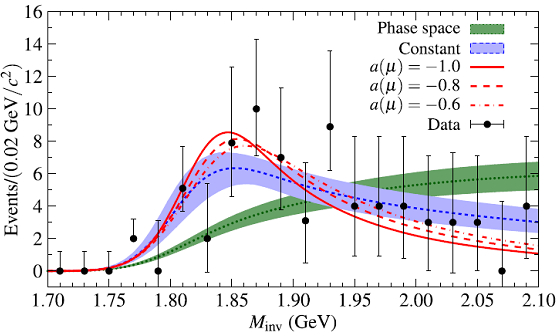The researchers in the High Energy Nuclear Physics Group at Institute of Modern Physics,Chinese Academy of Sciences(IMP), studied the role of the h1 state in the J/ψ→ηh1→ηK*0K*0bar decay. By including the h1 state, the experimental data can be well reproduced.
In 2010, the BES Collaboration found there was a clear enhancement in the K*0K*0bar mass distribution in the J/ψ→ηK*0K*0bar decay. Such an enhancement is usually a signature of an L=0 resonance around the threshold, which in this case would correspond to an h1 state with quantum numbers IG(JPC)=0−(1+−). This h1 state was predicted by the Chiral Unitary theory in the K*K*bar interaction. Because of the quantum numbers conversation law, this state can only decay to K*0K*0bar channel, so the J/ψ→ηK*0K*0bar decay is a very good platform to study it.
In this work, by including the h1 state, which is dynamically generated from the interaction of K*K*bar, then the experimental data from BES collaboration can be well fitted. From Fig. 1 one can see that the fitting results can describe the experimental data fairly well. Fig.1 shows that the bump structure observed by BES Collaboration in the J/ψ→ηK*0K*0bar naturally comes from the creation of this h1 state with mass and width around 1830 MeV and 110 MeV, respectively. Hence, more and precise experimental data on the J/ψ→ηK*0K*0bar decay can be used to determine the existence of this h1 state through the J/ψ→ηh1→ηK*0K*0bar decay.
The related results have been published in Phys. Lett. B 728, 319 (2014).

Fig.1 The K*0K*0bar invariant mass spectrum of J/ψ→ηK*0K*0bar decay. (Image by IMP)

